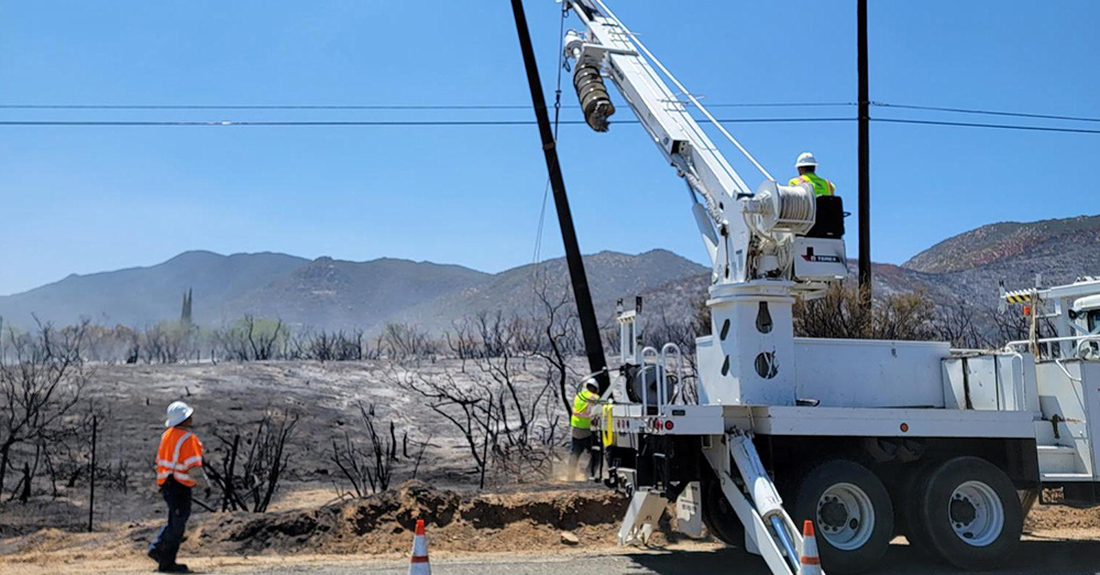
Utility grids power homes, businesses, and critical infrastructure, making them essential to modern life. Severe weather events, which are growing in frequency and intensity, threaten the stability of these grids. Understanding the specific impacts highlights the need for more resilient systems and innovative solutions.
Physical Damage to Utility Grids
Severe weather inflicts significant physical damage on utility grids. High winds uproot poles, snap cables, and send debris crashing into critical components. Ice accumulation from winter storms adds weight to power lines, causing them to sag or collapse.
Floodwaters seep into substations, shorting out equipment and corroding vital parts of the grid. Experts continually emphasize the impact of severe weather on utility grids as a leading cause of prolonged outages and costly repairs. Addressing vulnerabilities requires targeted efforts to strengthen grid infrastructure and reduce the risks of physical damage.
Damage To Power Line Poles and Transmission Equipment
Hurricanes and tornadoes topple poles and scatter transmission equipment, cutting off power to entire regions. Utility companies face challenges in replacing poles during severe weather recovery efforts. Industry leaders, including McWane Poles, design durable products to withstand the destructive forces of nature.
Advanced materials and innovative designs offer solutions to reduce pole failure rates. Many traditional poles lack the structural strength to endure high winds or heavy debris impact.
The growing adoption of composite poles demonstrates the industry’s commitment to improved resilience. Communities benefit significantly from upgrades that reduce outages and speed up recovery. Engineers continue to study weather patterns to refine pole designs and adapt to emerging challenges.
Substation and Transformer Failures
Flooding from heavy rains or storm surges causes widespread substation failures. Transformers often succumb to lightning strikes or water damage, leaving communities without electricity. Protecting these vital components requires investments in elevated substations and waterproof enclosures.
Rebuilding damaged substations often takes weeks or even months, delaying full restoration efforts. Utility companies increasingly adopt modular substations, which allow for quicker deployment in disaster-prone areas. Public awareness campaigns encourage local governments to prioritize flood protection for critical infrastructure.
Service Disruptions and Extended Outages
Severe weather disrupts power delivery, leading to extended outages that impact millions of customers. Utility companies struggle to restore power quickly when there’s infrastructure damage over vast areas.
Communities suffer economic losses and face hardships as businesses close and essential services halt. The impact of severe weather on utility grids extends beyond physical damage, creating ripple effects that harm society and the economy.
Economic Losses From Power Outages
Power outages during severe weather events result in lost revenue for businesses and unexpected costs for residents. Factories halt production, retailers close stores, and households purchase backup power supplies. Insurance claims rise as damages from prolonged outages accumulate. Strengthening grid resilience can significantly reduce these financial burdens.
Small businesses often struggle the most, as they lack the resources to recover from extended downtime. Lost wages for hourly workers compound the economic toll of outages. Utility companies face increased pressure from stakeholders to improve grid reliability. The broader economy feels the ripple effects as disrupted supply chains impact industries far from the storm’s path.
Delays in Emergency and Critical Services
Hospitals, emergency responders, and public safety agencies rely on consistent electricity to save lives during crises. Outages hinder operations, putting vulnerable populations at risk. Investing in grid modernization ensures faster recovery and minimizes service interruptions during emergencies.
Durable ductile iron power line poles from McWane Poles contribute to these efforts by providing solutions that improve grid reliability and reduce recovery times. Emergency shelters frequently struggle to maintain power, leaving evacuees in uncomfortable or unsafe conditions.
Utility providers coordinate with local governments to prioritize restoring electricity to critical services first. Mobile backup power units bridge the gap, but they aren’t a long-term solution. Strengthening grid resilience directly supports the safety and well-being of communities during severe weather events.
Environmental and Operational Impacts
Severe weather challenges utility grid operations and creates environmental consequences. Power generation and distribution systems must work harder to compensate for outages, increasing emissions and energy waste. Repair teams and resources become strained, leading to delays in restoring service and higher operational costs.
Increased Carbon Emissions From Backup Systems
Outages force businesses and residents to rely on generators, which burn fossil fuels and emit greenhouse gases. Investments in resilient infrastructure can reduce dependence on temporary solutions, supporting sustainability goals.
Many generators run inefficiently, consuming more fuel than necessary and creating additional pollution. Communities that rely heavily on diesel generators during outages experience spikes in local air pollution.
Renewable energy backup systems, such as solar-powered batteries, offer cleaner alternatives for short-term energy needs. Long-term investment in sustainable grid solutions balances environmental concerns with the need for reliable power.
Strain on Repair Teams and Resources
Repair crews face logistical challenges during severe weather, often working around the clock under dangerous conditions. Equipment shortages and inaccessible areas further complicate restoration efforts. Allocating resources more effectively and employing advanced technologies can help repair teams work faster and safer.
Extended outages place significant physical and emotional strain on repair workers, increasing the risk of accidents. Utility companies increasingly rely on predictive analytics to identify and address vulnerable grid components before a storm hits.
Cross-state collaboration among utility providers enables faster mobilization of repair teams during widespread weather events. Community outreach efforts educate residents on safety precautions to reduce risks for both workers and the public.
Increased Need for Advanced Materials and Technology
Advanced materials and modern technologies strengthen utility grids against severe weather impacts. Innovations in pole design, smart grids, and predictive maintenance tools enhance resilience and reduce the likelihood of catastrophic failures.
Innovations in Utility Pole Design
Utility poles must endure high winds, ice loads, and other severe weather conditions. Modern designs incorporate advanced materials that resist wear and withstand extreme forces.
Companies like McWane Poles lead the way in providing durable and reliable poles that minimize weather-related damage. Engineers test poles under extreme conditions to ensure they meet rigorous safety standards.
Smart Grids and Predictive Technologies
Smart grids leverage advanced sensors and communication tools to detect vulnerabilities before they lead to outages. Predictive technologies help utility companies anticipate failures and respond more effectively. Innovations enable faster restoration times and better preparation for severe weather events.
Utility providers collect real-time data to monitor grid performance and preemptively address potential disruptions. Automation in grid operations reduces human error and speeds up recovery efforts.
Predictive maintenance tools allow utilities to allocate resources more efficiently, saving time and costs. Smart grid technology empowers customers to manage their energy usage during emergencies while reducing strain on the system.
A resilient utility grid is a lifeline for communities facing the growing threat of severe weather. Investments in innovative materials, smarter technologies, and forward-thinking design empower utility companies to withstand natural forces and recover more quickly. Contact McWane Poles to learn how ductile iron poles are the best choice for making a modern, resilient utility grid.

